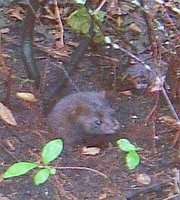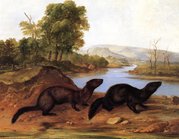Mink
A mink is any of several furry, dark-colored, semi-aquatic, carnivorous mammals of the family Mustelidae, which also includes the weasels. It is naturally found in North America, northern Europe, and most of Russia west of Ural Mountains. more...
Mink fur has been highly prized for its use in clothing, with hunting giving way to large-scale mink farming. It has also been a focus of much animal rights activism.
Subspecies
The two best-known extant species are the European Mink (Mustela lutreola), sometimes known as the marsh-otter, and the American Mink (Mustela vison). Another form, Mustela sibirica from eastern Asia, is variously known as the Siberian Weasel, Siberian Mink, or Siberian Polecat. It is closely related to the European Mink.
The European Mink inhabits Sweden, Poland, Finland, the mouth of Danube, south-west France, some regions of Spain (Basque Country, Navarre and La Rioja) and the greater part of Russia west of the Ural Mountains. Formerly it extended across all Europe.
The American Mink is found in places which suit its habits throughout almost all North America, from Florida to the Arctic. An endangered subspecies, the Everglades Mink (Mustela vison evergladensis), is endemic to the Florida Everglades.
American Mink of other subspecies have found their way into the wild in Europe (including Great Britain) and South America, as escapees from fur farms, and are currently expanding their range on those continents. In parts of Russia, this species was deliberately introduced to provide quarry for fur trappers.
Description
The following description, chiefly of the American species but almost equally applicable to that of Europe, is from Dr Elliott Coues's Fur-bearing Animals of North America, 1877.
- In size it much resembles the English polecat—the length of the head and body being usually from 15 to 18 inches , that of the tail to the end of the hair about 9 in . The female is considerably smaller than the male. The tail is bushy, but tapering at the end. The ears are small, low, rounded, and scarcely project beyond the adjacent fur. The pelage consists of a dense, soft, matted under-fur, mixed with long, stiff, lustrous hairs on all parts of the body and tail. The gloss is greatest on the upper parts; on the tail the bristly hairs predominate. Northern specimens have the finest and most glistening pelage; in those from southern regions there is less difference between the under- and over- fur, and the whole pelage is coarser and harsher. In colour different specimens present a considerable range of variation, but the animal is ordinarily of a rich dark brown." The coat can be almost black or black, and tends to be darker and thicker in the winter. To compensate for the fact that the animal has little subcutaneous fat, this fur traps air bubbles that keep it warm during its frequent dives into often-frigid water to search for prey.
It is sometimes possible to distinguish one species from the other based on the fact that the American Mink usually lacks a large white patch on its upper lip, while the European Mink always possesses one. Any mink without such a patch is most likely an American Mink, but an individual with such a patch in continental Europe cannot be certainly classified without looking at the skeleton. The European Mink always and the American Mink usually has a white spot on the lower lip, which continues in broken or unbroken fashion to form ventral markings. Since each is a different shape, it is possible to recognize individuals based on these ventral patterns. Fur also grows white over a scar and older mink tend to have more such patches, although absolute age is difficult to quantify without studying the animal from birth. In fur farms, mink are generally slaughtered after eight months, but can live several years in the wild (although mortality is high, especially among dispersing juveniles).
Read more at Wikipedia.org




